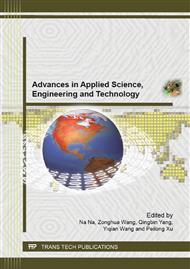[1]
Xu Xiaoguang, Li Weiying: Pay attention to the establishment of China's strategic petroleum reserve. Chinese Consulting Engineers. 3(2003), pp.21-23.
Google Scholar
[2]
Yu Miao: Study of the Construction of China's Strategic Petroleum Reserve. University of International Business Economics. (2006).
Google Scholar
[3]
Chen Haitao: Location for Strategic Petroleum Reserve Base in China Based on Fuzzy Comprehensive Evaluation and Maximal Covering Models. Science and Technology Management Research. 20(2010), pp.222-227.
Google Scholar
[4]
Zhu Genming: Approach the Operation of evaluation system of China's Strategic Petroleum Reserve. Modern Business. 12(2010), pp.162-167.
Google Scholar
[5]
Owen Nick A., Inderwildi Oliver R. and King David A: The status of conventional world oil reserves—Hype or cause for concern. Energy Policy. 8(2010), pp.4743-4749.
DOI: 10.1016/j.enpol.2010.02.026
Google Scholar
[6]
Okullo Samuel J., Reynès Frédéric: Can reserve additions in mature crude oil provinces attenuate peak oil? Energy. 36 (2011), pp.5755-5764.
DOI: 10.1016/j.energy.2011.05.051
Google Scholar
[7]
Wu Xuefen, Dong Yongmao: Take Zhejiang Province as an example to analyze the ability of absorbing employment in different sectors based on Input-Output Model. Zhejiang Social Sciences. 2(2006), pp.44-48+61.
Google Scholar
[8]
Yin Fancheng, Wang Yuliang and Huang Jianyuan: Analyze the Employment-driven effect Based on Input-Output Employment-contribution Model. Statistics and Decision 4(2010), pp.108-110.
Google Scholar
[9]
Tregenna Fiona: The contributions of manufacturing and services to employment creation and growth in South Africa. South African Journal of Economics 76(2008), pp.175-204.
DOI: 10.1111/j.1813-6982.2008.00187.x
Google Scholar
[10]
Charles E. Scott, Nancy A. Williams: Identifying industries for employment development using input-output model. American Economist (2010).
Google Scholar


